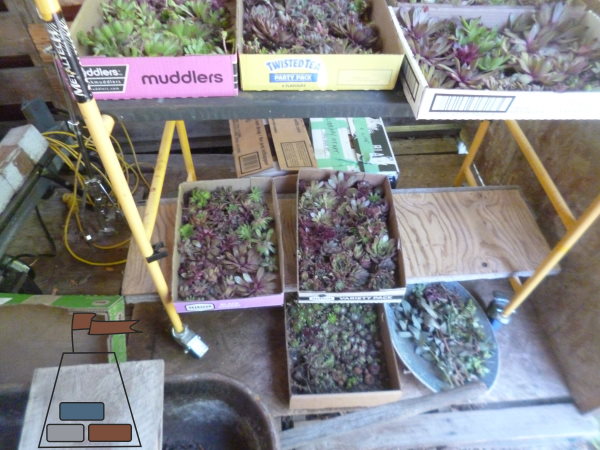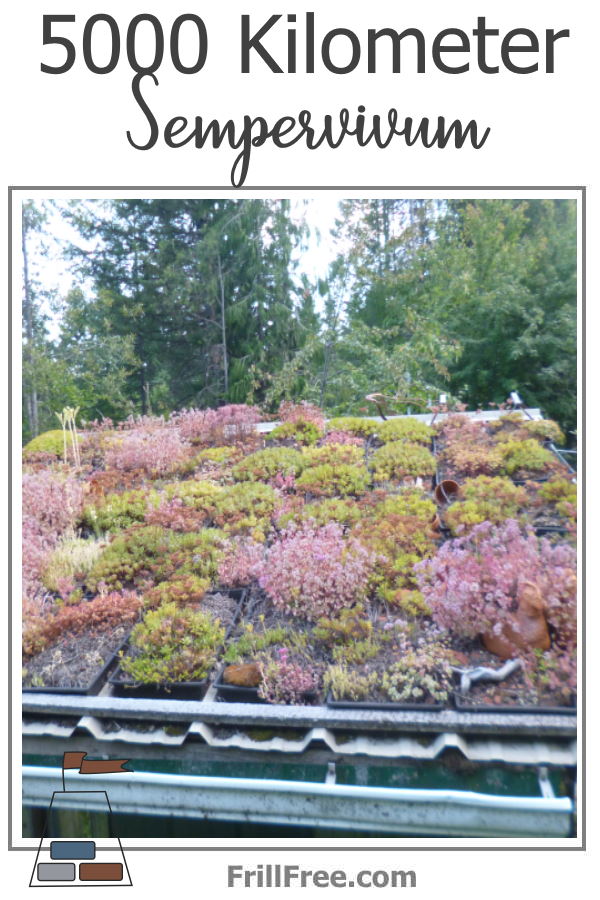- Homesteading
- Growing Ornamental Plants
- 5000 Kilometer Sempervivum
5000 Kilometer Sempervivum
Moving thousands of plants across the continent is a trek like no other
I planned ahead when I knew I would be moving all the way across the continent, even if I had no idea where I would end up. My Sempervivum made the trip too, all 5000 kilometers of it.
We traveled in a 19' RV, so there was no room for plants, at all. So how did I do it? I packaged all the plants I could find, especially if they were chicks and not rooted yet, put them in boxes and mailed them across the country.
The special trick with Sempervivum is that if completely dried out, they go into a dormancy and can be shipped in the dark for up to two weeks.
The first two batches I did went perfectly. I dried them in flats in the woodshed, where they got light but no water. They took two weeks or so to reach critical mass of completely dry but not dead.
 5000 Kilometer Sempervivum in the process of careful drying
5000 Kilometer Sempervivum in the process of careful dryingI made arrangements to send them via Canada Post, to a friend in PEI. I thought I made it clear that these were foster plants, to be cared for and then when I arrived in Atlantic Canada, they would be split up between us.
I even forwarded some cash so she could buy some soil geared towards the Sempervivums best health.
It was not to be, in the end, unfortunately. By the time we got to our destination, many of the plants had been sold at farmers markets, and the remaining ones were in poor shape due to being potted into the native red clay of PEI.
Sempervivum need fast draining soil, and prefer it shallow. Although the thought was there, these are unique plants with specific requirements, not to be plopped into the same soil type as that used for cabbages or zinnias.
The other place I sent some to was a better choice, in some ways. Mary was a woman in Nova Scotia I met online in a gardening group on Facebook, and she offered to take on the challenge of looking after the plants until I arrived.
She understood the assignment; to take care of them in a bed for the winter, then dig them up for me to either pick up or to be mailed to me.
In August, after we had purchased our house, and while waiting for possession on September 1st, I emailed her and she dutifully followed my directions and stuck two boxes in the mail. The first one arrived when we were still in Belfast, at the first woman's place. I didn't know what to do with all these plants, so I put them upright in many beer flats, and there seemed to be plenty from both sources.
This is when the story takes a disturbing turn, and needless to say a friendship was ended. I stacked up the trays of Semps, loaded them into the RV, and made our way to our new home.
The second load arrived from Mary, and then a few short weeks later, I heard that she had taken MAID, medical assistance in dying, due to cancer. As she was herself a doctor, she no doubt was fully aware of what the future held for her, and decided not to put herself and her family through it. These Sempervivum have a poignant meaning to them, from that.
Then, all those flats, eight or nine of them, spent the winter beside the house. All winter. In sleet, and snow, and dead of night. With no soil.
So why did I go to all this trouble and expense?
Well, guilt, and love for the beauty of these amazing plants for the most part. The other part might be love of a horticultural challenge.
I got the original 160 named varieties from Jack Broxholme, a Yorkshireman like my Dad who grew Sempervivum in Burlington, Ontario under the name of Cavendish Perennials. We had a great long distance relationship, sometimes spending considerable time on the phone. I loved hearing his accent, just like my Dads.
I believe his son is carrying on the nursery, but not online, I don't think. So these thousands of plants that came across Canada with me are the last remaining members of their tribe. They no longer have names as the tags disintegrated long ago. They are still gorgeous, and still tough as nails.
Now, in April, they look like they're emerging from dormancy, and are ready to go. I have to build a bed, and get them into it for the summer, which according to local sources, could be short.
I'm sure the 5000 Kilometer Sempervivum will be extremely happy just to get into some well drained soil, no matter how short the season might be.
Update August 2024
I'm happy to say that the Sempervivum are thriving after a rocky couple of months adjusting to the extreme humidity and the high temperatures we've been experiencing here on the east coast.
My idea to plant them on top of a pile of rubble was genius, they all look extremely healthy and are growing, no root rot or shriveled leaves in sight. Next thing will be chicks.
Update July 2025;
The Semps grew great, unfortunately so did the dandelions and Sedum that arrived along with the rest of the plants. Even ripping out handfuls and giving them away didn't diminish their exuberance. I may end up tearing the whole bed apart and replanting it. Next year...















